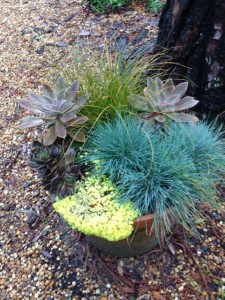Living in a condo, apartment, or home with small yard does not mean you can’t garden at home. Whether you are interested in edible plants or ornamentals you can create a fit that is right for your space by using containers.
The first step in container gardening is the same as for traditional landscaping. First, asses your site to determine the cultural situation. Is it sunny or shady? Is water available from rainfall or from a nearby spigot? Will salt or wind be a factor? Are there height and width limitations? All of these need to be taken into consideration when you are planning to plant. These are elements that we have very little control over, so it is best to choose the right plants for the place you have.
Choose a container that will allow for adequate root growth and good drainage. If growing annuals, perennials, or small vegetables, a pot that is 12-18” deep should be sufficient. For shallow rooted or plants that like dry conditions you can go smaller. If plants grow tall make sure that the weight of the soil and pot is enough to keep it upright in gusty winds. It is not necessary to buy a container, you can reuse something as long as the water will drain and it is sturdy. Large containers may not need to be filled completely, but can be filled with a lightweight filler such as upside down nursery pots, water or soda bottles with lids, or packing peanuts. Choosing a light weight filler material makes the container easier to turn or relocate if needed and reduces the cost of potting soil.
Once you have determined site conditions, select the type of plants you would like to grow. When choosing edibles, the amount of sunlight available may be a limiting factor. Although some herbs and vegetables may benefit from a little bit of shade, they still need a bright location in order to produce well. If your site is very shady, consider shade loving ornamentals such as fern, hosta, and impatiens.
Understand the sunlight, water, and fertilizer needs of each plant. Group plants together that have similar requirements because they will receive the same care. Most herbs like a hot, dry situation and very little to no fertilizer. Grouping one of these herbs with a tomato plant that needs consistent watering and regular fertilizer will create a situation where one plant will perform poorly.
Container gardens require more care than plants in the ground because they dry out faster and may get no water from rainfall, if placed in a covered area. Consider using micro irrigation designed for containers or choose plants with low water needs such as the grasses and succulents.
To read more about container gardening read Container Gardening for Outdoor Spaces ENH1095.
The Foundation of the Gator Nation
An Equal Opportunity Institution
- Thinking of Starting a Cut Flower Business? Don’t miss out on Cut Flower 101! - October 30, 2025
- 2025 Gardening in the Panhandle LIVE! Great Southeast Pollinator Census – Bee a Citizen Scientist! Wrap Up - September 18, 2025
- Will you Bee a Citizen Scientist? - August 15, 2025

